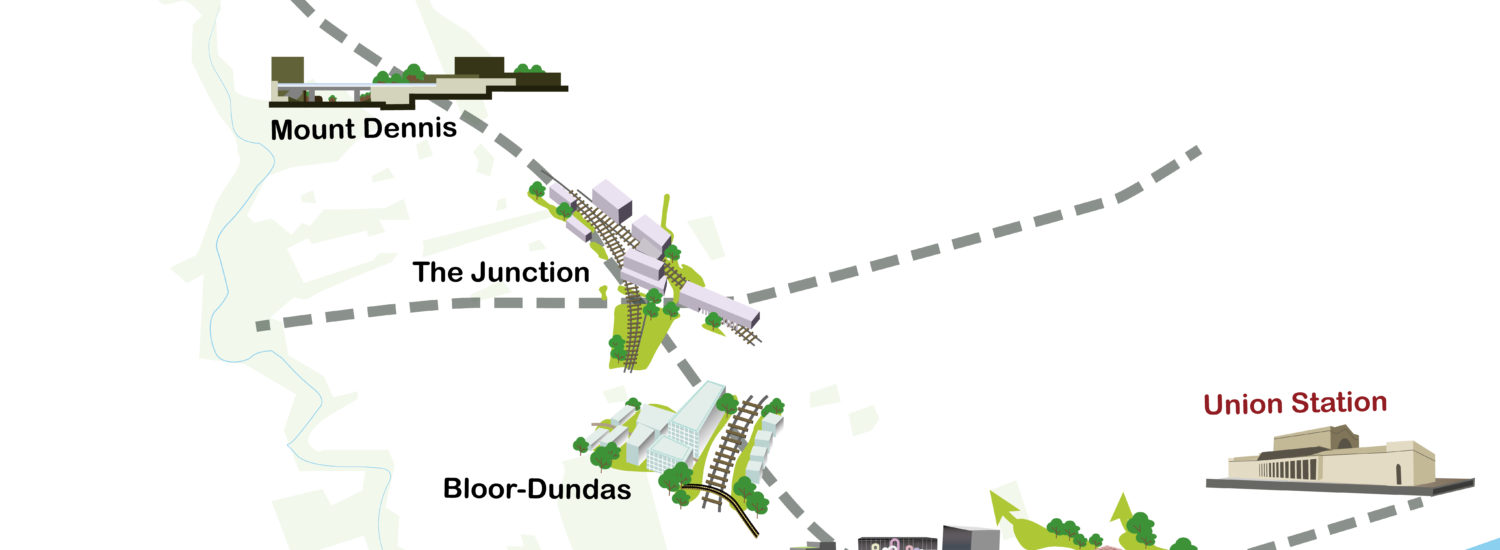Tapping the Potential of the West Toronto Rail Corridor is an exhibition showcasing work by the Winter 2014 Urban Design graduate students from the University of Toronto’s John H. Daniels Faculty of Architecture, Landscape and Design. As part of an urban design studio led by Ken Greenberg and Gaston Soucy, the students focused on the untapped potential along the West Toronto Rail Corridor. The exhibition concentrates on a Development Framework that builds on existing plans, initiatives, and proposals associated with the transportation, urban design, architecture, landscape, and greenspace along the West Toronto Rail Corridor.
The West Toronto Rail Corridor represents an extraordinary underutilized land resource and a valuable opportunity to support neighbourhood intensification in Toronto. It passes through the West Toronto Rail Path incorporating many West Toronto neighbourhoods along its way from The Junction, to Liberty Village, to the downtown core.
A number of critical initiatives are already underway in the corridor including an extension of the railpath to the Downtown core, making it one of the most important active transportation corridors in the city. Upgrades by Metrolinx will provide better transportation services to and from the downtown, and upon completion, GO Transit will deliver improved commuter service to the western portion of the GTA, while Metrolinx will operate theAir Rail Link between Toronto’s Union Station and Pearson International Airport.
However, there is still opportunity for improvement. The communities along the corridor have the potential to become unique 21st century neighbourhoods, with GO stations, subway stops, crossing LRT lines, and bicycle & pedestrian trails along its length. Existing resources – businesses, commerce, schools, and community centres – would benefit from strengthened connections with the rest of the city. Piecemeal redevelopment is emerging along the corridor, but the lack of a guiding vision leaves the neighbourhoods vulnerable to undesirable forms of disorganized growth.
“Tapping the Potential of the West Toronto Rail Corridor” envisions a consolidated corridor using a planning and design strategy that extends beyond the confines of a linear park and, in turn, connects the corridor with the surrounding neighbourhoods, park systems and the larger city beyond. The ultimate goal is to provide a grand vision for the region that challenges the traditional gridded street and block pattern developments, and experiments with alternative transportation, urban and public realm fabrics, forms, and functions that promote healthy economic and social growth.
Furthermore, a complimentary exhibition, #railpathTO, the West Toronto Railpath Extension Study by the regionalArchitectsPlanning Alliance consulting firm, focuses on the continuing work on the extension of the railpath itself undertaken by the City of Toronto. It highlights elements of the interactive #railpathTO exhibit that was part of this year’s Gladstone Grow Op – Exploring Landscape and Place event (between April 24th -27th). This exhibition opens September 4th at Urbanspace Gallery and will run concurrently with “Tapping the Potential of the West Toronto Rail Corridor.”
Curated by:
University of Toronto’s Urban Design Program



